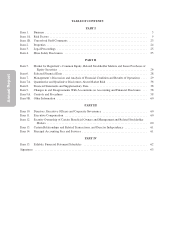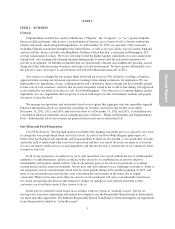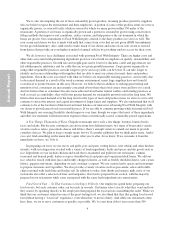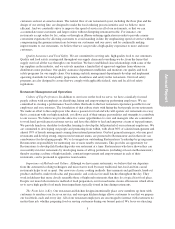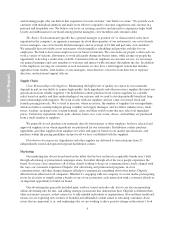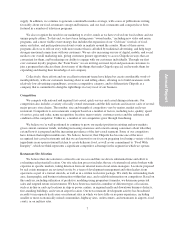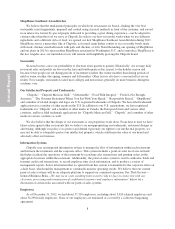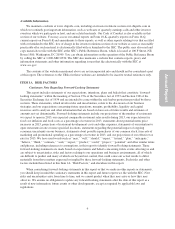Chipotle 2012 Annual Report Download - page 14
Download and view the complete annual report
Please find page 14 of the 2012 Chipotle annual report below. You can navigate through the pages in the report by either clicking on the pages listed below, or by using the keyword search tool below to find specific information within the annual report.
proportion of our recent openings being in higher rent sites than we have historically targeted. It may also be
difficult for us to attract a customer base if we are not able to staff our restaurants with employees who perform
to our high standards. If we are unable to build the customer base that we expect for new restaurant locations or
overcome the higher fixed costs associated with new restaurant locations, new restaurants may not have similar
results as our existing restaurants and may not be profitable. We also have lowered the average development cost
for new Chipotle restaurants in the U.S. significantly in recent years, from about $916,000 in 2008 to about
$800,000 in 2012. In the event we are not able to achieve the average development costs we expect for 2013 or
sustain the benefits achieved in prior years, which could result from inflation, project mismanagement or other
reasons, our new restaurant locations could also result in decreased profitability. Additionally, our new restaurant
development activity has broadened recently to incorporate trade areas or restaurant sites in which we have little
or no prior experience, including smaller or more economically mixed communities, highway sites, outlet
centers, and restaurants in airports, food courts, or on military sites. The risks relating to building a customer base
and managing development and operating costs may be more significant in some or all of these types of trade
areas or restaurant sites.
In addition, we have now opened restaurants in nearly all major metropolitan areas across the U.S. New
restaurants opened in existing markets may adversely impact sales in previously-opened restaurants in the same
market as customers who frequent our established restaurants begin to visit a newly-opened restaurant instead.
This impact could worsen as we open additional restaurants, and could make it more difficult for us to increase
comparable restaurant sales and profitability. Existing restaurants could also make it more difficult to build the
customer base for newly-opened restaurants in the same market.
Our expansion into new markets may present increased risks due to our unfamiliarity with those areas.
Some of our new restaurants are located in or planned for markets where we have little or no operating
experience. For instance, over the past three years we’ve opened five restaurants in London and one restaurant in
Paris, our first restaurants outside of North America, and during 2013 we plan to open an additional restaurant in
London, an additional restaurant in Paris, and our first restaurant in Germany. New markets, particularly outside
the U.S., may have different competitive conditions, consumer tastes and discretionary spending patterns than
our existing markets. As a result, new restaurants in those markets may be less successful than restaurants in our
existing markets. Consumers in a new market may not be familiar with the Chipotle brand, and we may need to
build brand awareness in that market through greater investments in advertising and promotional activity than we
originally planned. Due to lower consumer familiarity with the Chipotle brand in new markets, restaurants
opened in these markets, particularly outside the U.S., may have lower average restaurant sales than restaurants
opened in existing markets. We may find it more difficult in new markets to hire, motivate and keep qualified
employees who can project our vision, passion and culture. In addition, restaurants in new markets may have
higher construction, occupancy or operating costs than restaurants in existing markets, and may also have
difficulty finding reliable suppliers or distributors or ones that can provide us, either initially or over time, with
adequate supplies of ingredients meeting our quality standards. Sales at restaurants opened in new markets may
take longer to ramp up and reach expected sales and profit levels, and may never do so, thereby affecting our
overall profitability. Some or all of these factors may be more pronounced in markets outside the U.S. due to
cultural, regulatory or economic differences with which we are not familiar, which may have a particularly
adverse impact on our sales or profitability in those markets and could thereby adversely impact our overall
results. Our overall results may also be affected by currency risk on the transactions in other currencies and
translation adjustments resulting from the conversion of our international financial results into the U.S. dollar.
ShopHouse Southeast Asian Kitchen may not contribute to our growth.
We believe that the fundamental principles on which Chipotle restaurants are based—finding the very best
sustainably raised ingredients, prepared and cooked using classical methods in front of the customer, and served
in an interactive format by special people dedicated to providing a great dining experience—can be adapted to
cuisines other than the food we serve at Chipotle. In order to see how our model works when we use different
12
Annual Report


